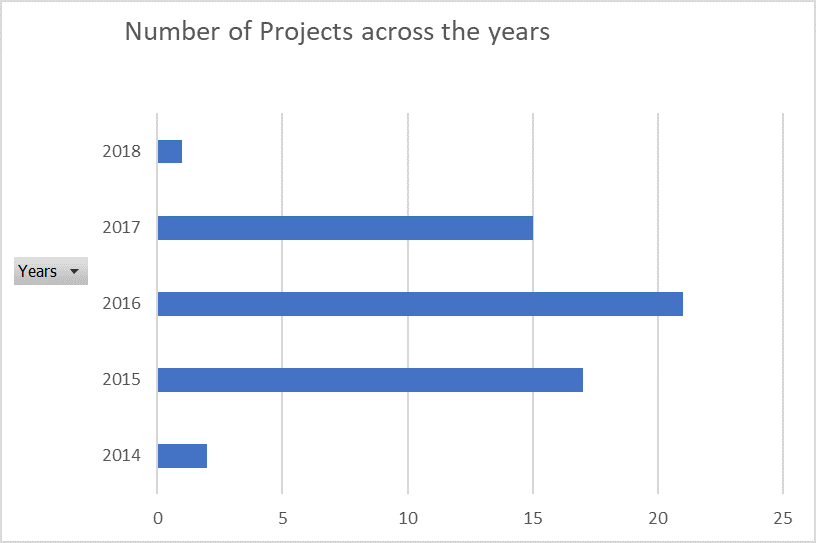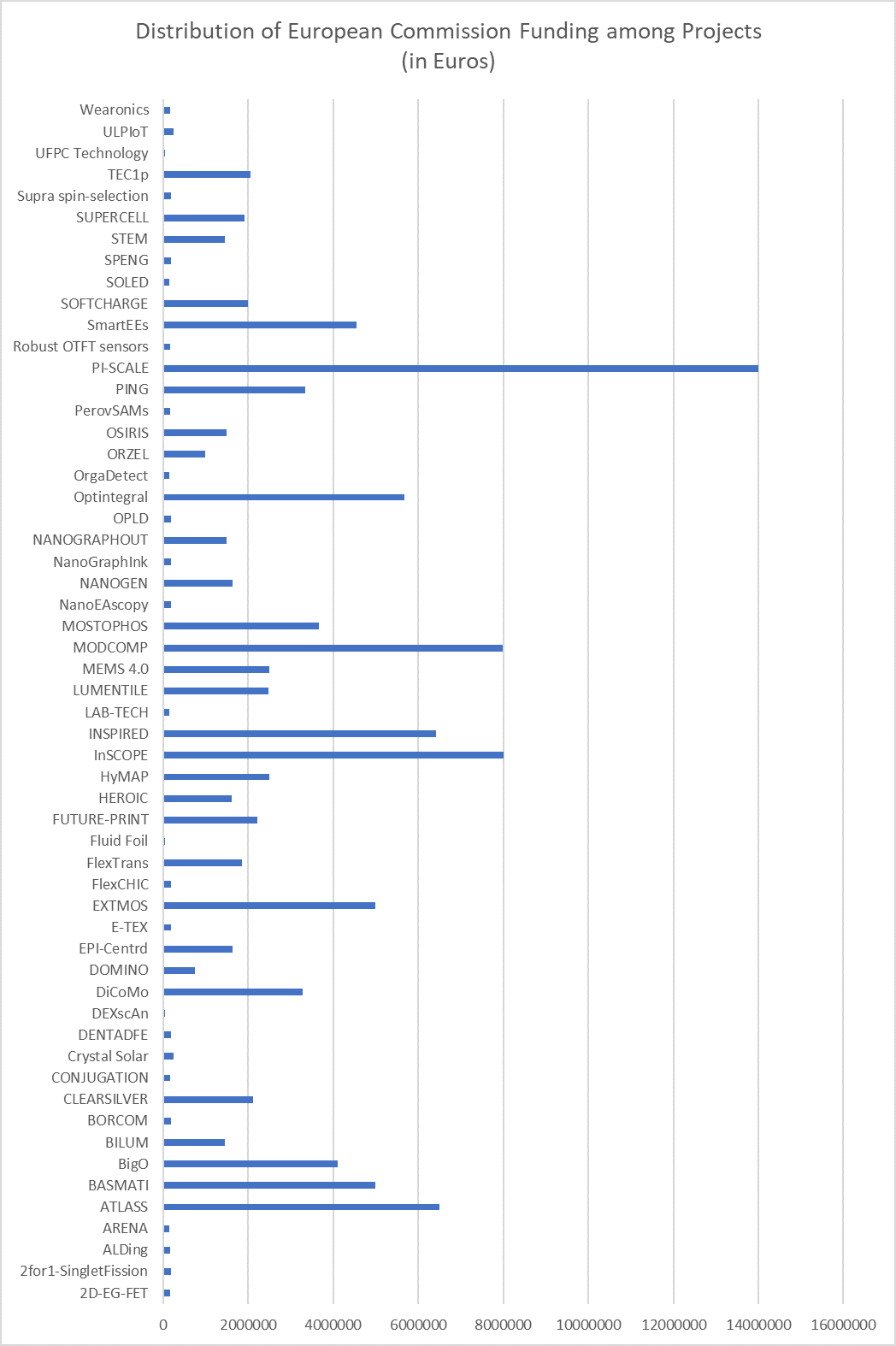Flexible, Wearable and Organic Electronics projects within H2020
Previously, in Horizon 2020 programme around 56 projects have been funded in technological areas involving flexible, wearable, printed and/or organic electronics. Out of the 56 projects, eight are funded through Innovation Action scheme, six through Research and Innovation Action scheme, nineteen through Marie Skłodowska-Curie Actions, seventeen via European Research Council, five through the SME schemes and one project was funded through Coordination and Support Actions. Even though most projects to date were commenced in the year 2016, more funding was dedicated to Flex electronics and organic electronics in the year 2015.
Private companies involved in more than one project are in this technological field are AMIRES s.r.o (Czech Republic), FlexEnable (UK), M-SOLV LTD (UK), Silvaco Europe Ltd (UK) and Siemens Healthcare (Germany). Among the RTOs, the main players are CEA (France), IMEC (Belgium) and Joanneum Research (Austria). Other key players in the field of flexible and wearable electronics are VTT (Finland), Max-Planck (Germany) and Aristotle University of Thessaloniki (Greece).
The various mature technologies within the projects that were previously funded via RIA and IA schemes are as outlined below:
The various mature technologies within the projects that were previously funded via RIA and IA schemes are as outlined below:
- Development of lED displays for advertisement manufacturing process combining Roll-to-Sheet and Roll-to-Roll of flexible electronics with In-mould hybrid integration of TOLAE (Thin Organic and Large Area Electronics) and photonics components – Optintegral project (IA)
- demonstrate the influence of different surface enhancing and modification techniques on Carbon fibre -based materials for high value and high-performance applications including CNF-based structures for flexible electronics applications- MODCOMP project (IA)
- Improving the specificity and sensitivity of flat panel X-ray detectors and more importantly advancing the safety of environment and health by establishment of a new solvent-free manufacturing process for large area hybrid-organic electronics – DiCoMo project (RIA)
- Leveraging the large area and organic electronics to turn classical ceramic tile into a “multifunctional electronic luminous tile” – LUMENTILE project (RIA)
- Developing a pilot line for the manufacture and system-level integration of flexible organic electronics OLEDs into products by creating an open access mode and serve customers from along the value chain with individual product designs, validation of upscaling concepts, and system-level flexible OLED integration – PI-SCALE project (IA)
- Taking advantage of wearable electronics and Big Data to collect data and quantify behavioral community patterns on child and adolescent obesity. The collected data will be used to reshape policies at a regional. national and European level on obesity by having in place data-driven effectiveness predictions about specific policies on a community and the real-time monitoring of the population response – BigO project (RIA)
- Moving beyond current TOLAE demonstration through a major technology jump that drives scalability towards nanoscale resolution and high-definition cost-effective printing. This will be achieved by engineering and scaling up to industrial lines, some new multifunctional high-performing inks and high-resolution roll-to-roll (R2R) process or sheet-to-sheet (S2S) processes of electronic printing of including nano-imprinting and gravure printing – ATLASS project (IA)
- Acknowledging the potential of printed electronics as revolutionary to electronics industry with an annual growth rate of 32.5% and ability to regain the market share of Europe in electronics, there is need to ensure there is sufficient industrial supply of nanomaterials which are low cost, high performance., environmentally friendly and tailored for high throughput systems. Therefore, better collaboration will be enhanced and encouraged between supply chain partners to ensure nanomaterial production and nanomaterial formulations are tailored for end use applications to meet this need – INSPIRED project (IA)
- Applying the concept of nanomaterials for printing application to flexible printed electronics and more specifically to printed batteries and provision of new sources of nanomaterials (for example metallic particle (Ni. Cu. Al) and layered positive active material such as LiNi1/3Mn1/3Co1/3O2 (NMC) and olivine LiFePO4) for the formulation of conductive and electrochemical inks to be used in flexible electronics – BASMATI project (IA)
- Providing an open access pilot line service for Hybrid Thin Organic and Large Area Electronics (H-TOLAE) technologies capable of sampling products at industrially relevant environment (TRL6) and system prototype demonstration in operational environment (TRL 7) – InSCOPE project (IA)
- Bringing flexible electronics from lab to market through the development of extremely thin, flexible and durable electronics and establishing the supply chain that allows for standardized manufacturing at the lowest cost and highest volumes of Near Field Communication (NFC) tags and cards and their printable substrates (paper, cardboard, plastic, …) for the advancement of Internet of Things and the ‘internet of games’ – PING project (RIA)
- Create a technology acceleration hub dedicated to help innovative companies to access new markets and grow their business in adopting OLAE (Organic Light Advanced Electronics) technologies in new products lines. The hub is essentially an organized European innovation network dedicated to OLAE. This network seeks to advise startups, small and medium companies interested in OLAE to be more competitive through innovation and new business models- SmartEEs project (IA)
- development of optoelectronic materials and devices (organic solar cells, photodetectors and image sensors as well as organic light-emitting diodes) which operate in the near infrared (NIR) region. OSNIRO –(MSCA)
- reduction of the time to market of OLEDS and organic thin film transistors and circuits with fast operation. Reduction of the production costs of organic devices by enabling a fully solution processed technology coupled with reduction of design costs at circuit level through an integrated model linking molecular design to circuit operation- EXTMOS (RIA)
- Modelling stability of organic phosphorescent light-emitting diodes so as to integrate various levels of theoretical materials characterization into a single software package, to streamline the research workflows in order for the calculations to be truly usable by materials engineers, complementary to experimental measurements- MOSTOPHOS (RIA)
- Development of a smart, wearable system, which will provide a personalized therapy for treatment of chronic wounds using the effect of blue light – MEDILIGHT (RIA)








